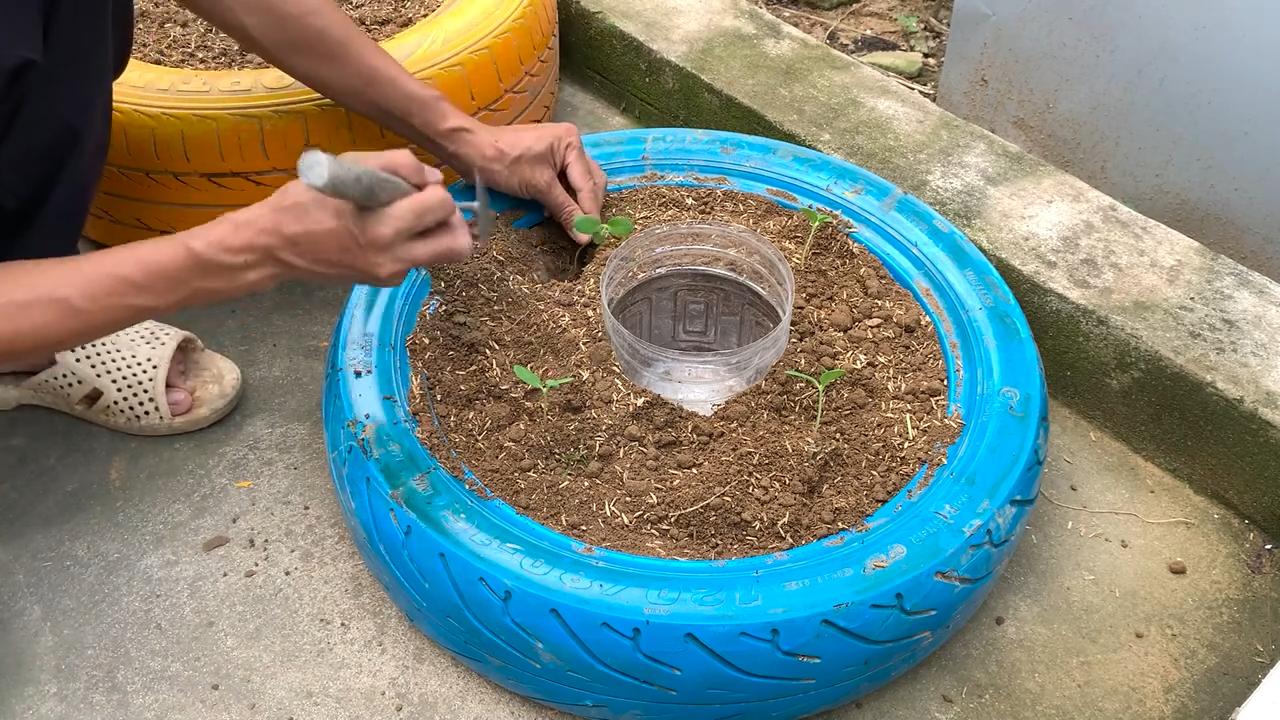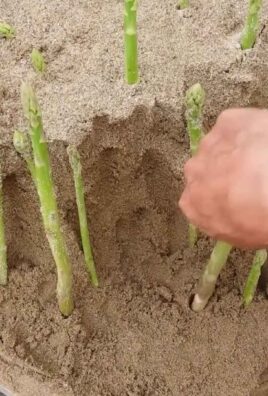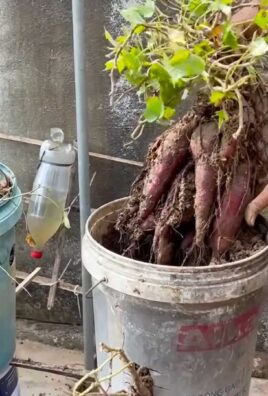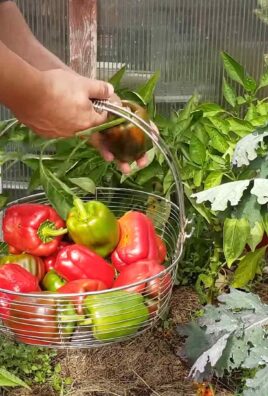Backyard Melon Growing Easy Way – sounds like a dream, right? Imagine biting into a juicy, homegrown melon, bursting with flavor, knowing you nurtured it from a tiny seed right in your own backyard. Forget those bland, store-bought melons! This isn’t just about growing food; it’s about connecting with nature, enjoying the fruits (literally!) of your labor, and impressing your friends and family with your green thumb.
Melons have a rich history, dating back to ancient Egypt and beyond, where they were prized for their sweetness and refreshing qualities. Cultivating them was once a skill reserved for experienced farmers, but I’m here to tell you that with a few simple tricks, backyard melon growing the easy way is totally achievable for anyone, even if you’re a complete beginner.
Let’s face it, gardening can sometimes feel overwhelming. But I’m going to break down the process into manageable steps, sharing my favorite DIY hacks and tips that will help you avoid common pitfalls and maximize your melon harvest. Why spend money on expensive melons when you can grow your own, knowing exactly what went into them? Plus, there’s nothing quite like the satisfaction of harvesting your own delicious, sun-ripened fruit. So, grab your gardening gloves, and let’s get started on this exciting journey to homegrown melon goodness!

Grow Delicious Melons in Your Backyard: An Easy DIY Guide
Hey there, fellow gardeners! Dreaming of biting into a juicy, homegrown melon this summer? You absolutely can make that dream a reality, even if you’re a beginner. I’m going to walk you through a super easy DIY method for growing melons right in your backyard. Trust me, it’s simpler than you think, and the taste of a melon you’ve nurtured yourself is unbeatable!
Choosing Your Melon Variety
Before we get our hands dirty, let’s talk melons. Not all melons are created equal, and some are definitely easier to grow in a backyard setting than others. Here are a few of my favorites for beginners:
* Cantaloupe: A classic choice! Cantaloupe is relatively easy to grow and offers that sweet, orange flesh we all love. Look for varieties like ‘Athena’ or ‘Hales Best Jumbo’ for good disease resistance.
* Watermelon (Bush Varieties): Watermelons can be space hogs, but bush varieties are perfect for smaller gardens. ‘Bush Sugar Baby’ and ‘Golden Midget’ are great options. They produce smaller, manageable melons.
* Honeydew: Honeydew melons are known for their smooth, green skin and subtly sweet flavor. ‘Honey Globe’ is a reliable choice.
Important Tip: Consider your local climate and growing season when choosing your melon variety. Check the seed packet or online descriptions for information on days to maturity and recommended growing zones.
Preparing Your Melon Patch
Melons are sun-loving, hungry plants, so proper preparation is key to success.
* Sunlight: Melons need at least 6-8 hours of direct sunlight per day. Choose a spot in your yard that gets plenty of sunshine.
* Soil: Melons thrive in well-drained, fertile soil. Amend your soil with plenty of compost or well-rotted manure before planting. This will improve drainage, add nutrients, and help retain moisture.
* Spacing: Give your melon plants enough room to grow. Cantaloupes and honeydews need about 2-3 feet of space between plants, while bush watermelons need about 3-4 feet.
* Support (Optional): For vining varieties, consider using a trellis or support system to keep the melons off the ground. This can help prevent rot and make harvesting easier.
Step-by-Step Planting Guide
Now for the fun part – planting! You have two options: starting seeds indoors or direct sowing. I usually prefer starting seeds indoors to get a head start, especially in areas with shorter growing seasons.
Starting Seeds Indoors (Recommended)
1. Timing: Start your melon seeds indoors about 4-6 weeks before the last expected frost in your area.
2. Containers: Use seed starting trays or small pots filled with seed starting mix. I like to use peat pots or biodegradable pots because they can be planted directly into the ground, minimizing root disturbance.
3. Sowing: Plant 2-3 seeds per pot, about ½ inch deep.
4. Watering: Gently water the seeds and keep the soil consistently moist but not soggy.
5. Warmth: Melons need warmth to germinate. Use a heat mat or place the seed trays in a warm location. The ideal soil temperature is around 70-80°F (21-27°C).
6. Light: Once the seeds germinate, provide them with plenty of light. Place them under grow lights or in a sunny window.
7. Thinning: Once the seedlings have developed a few true leaves, thin them to one strong seedling per pot.
8. Hardening Off: Before transplanting the seedlings outdoors, you need to harden them off. This means gradually exposing them to outdoor conditions over a period of 7-10 days. Start by placing them in a sheltered location for a few hours each day, gradually increasing the amount of time they spend outdoors.
Direct Sowing (If Your Climate Allows)
1. Timing: Direct sow melon seeds after the last expected frost when the soil has warmed up to at least 70°F (21°C).
2. Soil Preparation: Make sure the soil is well-prepared and amended with compost.
3. Sowing: Plant the seeds about ½ inch deep, spacing them according to the recommended spacing for your chosen variety.
4. Watering: Water the seeds gently and keep the soil consistently moist until they germinate.
5. Thinning: Once the seedlings emerge, thin them to one strong seedling per spacing.
Transplanting Your Melon Seedlings
Whether you started your seeds indoors or bought seedlings from a nursery, transplanting them into your garden requires a gentle touch.
1. Timing: Transplant your melon seedlings after the last expected frost when the soil has warmed up.
2. Hole Preparation: Dig a hole that is slightly larger than the root ball of the seedling.
3. Planting: Gently remove the seedling from its pot, being careful not to damage the roots. If you used peat pots, you can plant the entire pot directly into the ground.
4. Spacing: Space the seedlings according to the recommended spacing for your chosen variety.
5. Watering: Water the seedlings thoroughly after planting.
6. Mulching: Apply a layer of mulch around the plants to help retain moisture, suppress weeds, and regulate soil temperature. I like to use straw or shredded leaves.
Caring for Your Melon Plants
Once your melon plants are in the ground, they need regular care to thrive.
* Watering: Melons need consistent watering, especially during hot, dry weather. Water deeply and regularly, aiming for about 1-2 inches of water per week. Avoid overhead watering, as this can promote fungal diseases. Drip irrigation or soaker hoses are ideal.
* Fertilizing: Melons are heavy feeders, so they need regular fertilization. Use a balanced fertilizer (e.g., 10-10-10) every 2-3 weeks. You can also side-dress the plants with compost or well-rotted manure.
* Weeding: Keep the area around your melon plants free of weeds. Weeds compete with the plants for water and nutrients.
* Pest Control: Keep an eye out for common melon pests, such as aphids, squash bugs, and cucumber beetles. Use organic pest control methods, such as insecticidal soap or neem oil, to control these pests.
* Pollination: Melons need to be pollinated to produce fruit. If you’re not seeing any fruit developing, you may need to hand-pollinate the flowers. To do this, use a small paintbrush to transfer pollen from the male flowers to the female flowers. Female flowers have a small fruit at the base of the flower.
Recognizing and Addressing Common Problems
Even with the best care, you might encounter some challenges. Here are a few common problems and how to deal with them:
* Powdery Mildew: This fungal disease appears as a white, powdery coating on the leaves. Improve air circulation, avoid overhead watering, and use a fungicide if necessary.
* Blossom-End Rot: This condition causes the bottom of the melon to rot. It’s usually caused by calcium deficiency or inconsistent watering. Ensure consistent watering and amend the soil with calcium-rich amendments like bone meal.
* Cucumber Beetles: These pests can transmit diseases and damage the plants. Use row covers to protect young plants and handpick beetles as needed.
* Squash Bugs: These pests suck the sap from the plants, causing them to wilt and die. Handpick bugs and their eggs, and use insecticidal soap if necessary.
Harvesting Your Melons
The moment you’ve been waiting for! Knowing when to harvest your melons is crucial for getting that perfect, sweet flavor.
* Cantaloupe: Cantaloupes are ripe when the stem slips easily from the fruit with a gentle tug. The skin will also turn from green to a tan or yellowish color, and the melon will have a fragrant aroma.
* Watermelon: Watermelons are ripe when the tendril closest to the fruit turns brown and dry. The bottom of the melon (where it rests on the ground) will turn from white to yellow. You can also thump the melon – a ripe watermelon will sound dull and hollow.
* Honeydew: Honeydew melons are ripe when the skin turns from green to a creamy yellow color. The melon will also have a slightly soft feel.
Harvesting Tip: Use a sharp knife or pruning shears to cut the melon from the vine, leaving a short piece of stem attached.
Enjoying Your Homegrown Melons
Congratulations! You’ve successfully grown your own delicious melons. Now it’s time to enjoy the fruits (or rather, melons) of your labor. Slice them up, share them with friends and family, and savor the taste of summer

Conclusion
So, there you have it! Growing your own melons in your backyard doesn’t have to be a daunting task. By implementing this easy DIY trick, you’re not just planting seeds; you’re cultivating a personal oasis of sweet, juicy goodness. This method, focusing on optimizing space and providing targeted nourishment, dramatically increases your chances of a bountiful harvest, even in smaller gardens. Think of biting into a sun-ripened melon, bursting with flavor, knowing you nurtured it from seed to table. That’s the reward waiting for you!
This DIY approach to backyard melon growing is a must-try for several reasons. First, it simplifies the process, making it accessible to even novice gardeners. No more feeling intimidated by complex techniques or specialized equipment. Second, it promotes healthier, more vigorous plants, leading to larger and more flavorful melons. Third, it’s incredibly rewarding to witness the entire life cycle of your food, from tiny seed to delicious fruit.
But don’t stop there! Feel free to experiment with different melon varieties. Try growing cantaloupe, honeydew, or even watermelon using this same method. Consider adding companion plants like marigolds or basil to deter pests and attract pollinators. You can also adjust the nutrient solution based on your soil type and the specific needs of your chosen melon variety. For example, adding bone meal to the soil can provide extra phosphorus, which is essential for fruit development.
We’re confident that this DIY trick will transform your backyard into a melon-producing paradise. But the real magic happens when you share your experiences with others. We encourage you to try this method, document your progress, and share your results with us and the wider gardening community. Post pictures of your thriving melon plants, share your tips and tricks, and let us know what worked best for you. Together, we can unlock the secrets to successful backyard melon growing and inspire others to cultivate their own delicious harvests. So, grab your seeds, get your hands dirty, and prepare to enjoy the sweet taste of success! Let’s make this the year of the backyard melon!
Ready to get started?
Don’t hesitate! The sooner you begin, the sooner you’ll be enjoying the fruits (or rather, melons) of your labor. Remember, gardening is a journey, not a destination. Embrace the challenges, celebrate the successes, and most importantly, have fun!
Frequently Asked Questions (FAQ)
Q: What kind of melons work best with this DIY growing method?
A: This method is versatile and can be used for a wide variety of melons, including cantaloupe, honeydew, watermelon, and even smaller varieties like sugar kiss melons. The key is to choose varieties that are well-suited to your local climate and growing season. For smaller gardens, consider bush or compact varieties that don’t require as much space. Watermelons, due to their size, might need more support and space, but the core principles of this DIY method still apply.
Q: How often should I water my melon plants using this method?
A: Watering frequency depends on several factors, including the weather, soil type, and the size of your plants. Generally, you should aim to keep the soil consistently moist but not waterlogged. Check the soil moisture level regularly by sticking your finger about an inch into the soil. If it feels dry, it’s time to water. During hot, dry periods, you may need to water daily, while during cooler, wetter periods, you may only need to water every few days. Using a soaker hose or drip irrigation system can help deliver water directly to the roots, minimizing water waste and reducing the risk of fungal diseases.
Q: What kind of fertilizer should I use for my melon plants?
A: Melons are heavy feeders and require a balanced fertilizer to thrive. Look for a fertilizer with a ratio of N-P-K (nitrogen, phosphorus, potassium) that is appropriate for fruiting plants. A fertilizer with a higher phosphorus content is particularly beneficial for promoting fruit development. You can also supplement with organic fertilizers like compost tea or fish emulsion. Avoid over-fertilizing, as this can lead to excessive foliage growth at the expense of fruit production. Follow the instructions on the fertilizer label carefully.
Q: How do I protect my melon plants from pests and diseases?
A: Prevention is key when it comes to pest and disease management. Start by choosing disease-resistant melon varieties. Practice good garden hygiene by removing any dead or diseased leaves and debris. Companion planting with herbs like basil or marigolds can help deter pests. Regularly inspect your plants for signs of pests or diseases, such as aphids, squash bugs, or powdery mildew. If you spot any problems, address them promptly with appropriate organic pest control methods, such as insecticidal soap or neem oil. Ensure good air circulation around your plants to reduce the risk of fungal diseases.
Q: How do I know when my melons are ripe and ready to harvest?
A: Determining when a melon is ripe can be tricky, but there are several indicators to look for. For cantaloupe, the stem should slip easily from the vine when the melon is ripe. The skin will also turn from green to a tan or yellowish color, and the melon will have a fragrant aroma. For honeydew, the skin will turn from green to a creamy yellow color, and the blossom end will feel slightly soft. For watermelon, the tendril closest to the melon will turn brown and dry, and the underside of the melon (where it rests on the ground) will turn from white to yellow. You can also thump the melon; a ripe watermelon will have a deep, hollow sound.
Q: Can I grow melons in containers using this DIY method?
A: Yes, you can definitely grow melons in containers using this method, especially smaller varieties. Choose a large container with good drainage, at least 20 gallons in size. Use a high-quality potting mix and provide adequate support for the vines. Container-grown melons may require more frequent watering and fertilization than those grown in the ground. Make sure the container receives at least 6-8 hours of direct sunlight per day.
Q: What if I don’t have a lot of space in my backyard? Can I still grow melons?
A: Absolutely! This DIY method is particularly well-suited for small spaces. Consider growing melons vertically by training them up a trellis or fence. Choose bush or compact varieties that don’t require as much space. You can also grow melons in containers on a patio or balcony. Even a small space can yield a surprisingly abundant harvest with the right techniques.
Q: How can I improve pollination for my melon plants?
A: Melons require pollination to produce fruit. If you’re not seeing many bees or other pollinators in your garden, you may need to hand-pollinate your melon flowers. To do this, use a small paintbrush to transfer pollen from the male flowers to the female flowers. Female flowers have a small, immature melon at the base, while male flowers do not. Pollinate in the morning, when the flowers are open and the pollen is most viable. Attracting pollinators to your garden by planting pollinator-friendly flowers can also help improve pollination rates.
Q: What are some common mistakes to avoid when growing melons?
A: Some common mistakes to avoid include overwatering, underwatering, over-fertilizing, not providing adequate support for the vines, and neglecting to protect plants from pests and diseases. Pay close attention to your plants’ needs and adjust your care accordingly. Don’t be afraid to experiment and learn from your mistakes. Gardening is a learning process, and every season brings new challenges and opportunities.




Leave a Comment